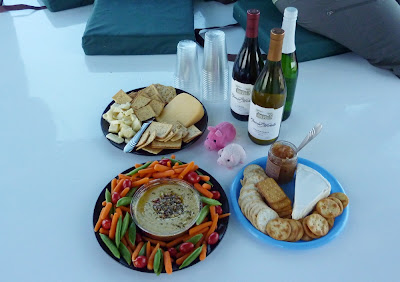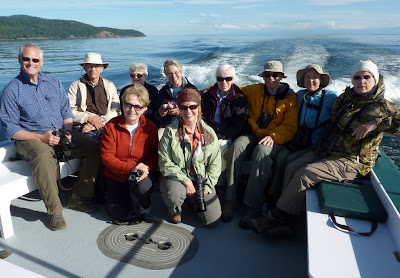Our breakfast, as always at Roche Harbor, was at the Lime Kiln Café at the end of the dock. If you click on the photo, the nearer building says "Roche Harbor Lime & Cement Co. Largest Lime Works West of the Mississippi." We'll see more about the history of this place in a later post.
Melissa greeted us wearing a hat woven from cedar strips, the traditional material and technique used by the original islanders for many articles of clothing.
We headed off towards American Camp, on the far south side of San Juan Island. This is the encampment site for the U.S. troops protecting the American claim to the San Juans, a twin to the English Camp we visited earlier (documented halfway through the previous post).
On the way the bus stopped at the Westside Preserve.
The view included Vancouver Island, just across the strait, and the Olympic Mountains that give the San Juans their drier climate, to the left in this panorama.
We continued south, and bypassed the main Visitor Center for American Camp in favor of driving down to South Beach. The extensive grasslands on the southwestern side of the island show how little rain falls compared to the other sections.
In the above photo we are paused on Pickett's Lane to admire the grasslands. Yes, that Pickett, who in 1859 was a captain in the U.S. Army and landed with the first U.S. troops to contest ownership of the island with the English. Four years later he would lead a division of the Army of Northern Virginia at Gettsyburg, a continent away.
South Beach had the usual signage about park rules and regulations; of particular interest to me was this diagram of the rules of orca-watching. The sign is actually out-of-date, recently the no-go radius was increased from 100 to 200 yards.
The tides and winds deposit a lot of driftwood on South Beach, as this Google Maps image shows.
View Larger Map
Absorbing the landscape, we scanned further and further along the horizon, and then spotted what we eventually decided was Mt. Rainier shimmering through the haze on the horizon.
Candy and Pat also strolled up the beach to admire a bald eagle perched on the driftwood.
On leaving the beach the bus turned southeast. Our goal was to walk down to a lagoon on the northern side of the island, which is not far at all because the island is less than a mile wide at this point:
View Larger Map
However, the bus could not turn around on the narrow road, and we continued down Cattle Point Rd. until we could take advantage of a loop. On the way, we made a fortuitous stop wherein we discovered a fox in the flowers.
Once the bus was pointed in the right direction, those who wanted to stroll down to the lagoon disembarked and followed a nature trail through the woods. This pocket of the island was still wet enough to support banana slugs, including this black beauty.
The lagoon was enjoyable to see, and the leg stretch was welcome, but we didn't discover as much wildlife as we had hoped. It turned out this would be compensated for in the afternoon.
We returned to Roche Harbor, and sailed out for a second and final orca-watching expedition around 2:30pm. There was a lot to see just leaving the harbor area, but first, a picture of our boat for the afternoon.
On the parallel dock, the most important service boat offered by the harbor.
Leaving the harbor, we saw this floatplane come in ...
and there was this sailboat ...
and the seals were hauled out in the sun.
Traveling by water parallel to our morning's track on land, we soon approached the Lime Kiln lighthouse.
The kayakers had likely put into the water just north of the lighthouse, at San Juan County Park.
We began to see various creatures as we continued southbound. Here, a guillemot (in the rather large Alcidae family) has popped up to the surface with a beak full of small fish.
For a while there were harbor porpoises also feeding.
Then J pod appeared, and this time they were awake and barreling up from the south. Some of these photos stretched the limits of my point-and-shoot camera, but they should give you an idea of what we were seeing in person and through binoculars.
This orca is falling back into the water after having leapt completely out of the sea.
Several of the orcas were also lobtailing, or slapping their tail fins against the sea, making a loud splash. You can feel the exuberance radiating from them when they do this.
This jumper is perfectly posed, so I offer it despite any fuzziness or graininess in the image.
As the pod swiftly approached and passed us, we had many excellent looks at the orcas. The speed and unpredictability of their actions made it hard to always snap the camera at the right time or at the right orca, but here is a good shot of a youngster swimming with his mother; only her fin is showing.
Here a jumper is landing on her back with a big splash. The rings from the jump out of the water are just behind her.
One orca passed by so close to the stern of our boat that all our jaws were agape.
J pod continued to zoom north, and Melissa laid out a spread for us to nosh on after we calmed down.
We stayed out a while longer, as the laggards of J pod passed by, but this trailing edge was not as acrobatically inclined, and any pictures would just be more fins, and just fins. Then it was time to return to Roche Harbor, grinning.
We had a satisfying group dinner at McMillin's restaurant, overlooking the harbor, despite the glare of the lowering sun on our table. Unfortunately, tomorrow we would leave Roche Harbor, to eventually return to Bellingham, and that meant it was time to pack again.





























No comments:
Post a Comment
Comments may not appear immediately as they are moderated by the author to eliminate spam. Please, no commercial links!